Deconstruction of Talking Tom Gold Run
Recently Outfit7 has released their new runner game Talking Tom Gold Run in the incredibly popular universe of Talking Tom. We’ve analyzed the game to find out if it’s going to be a hit.
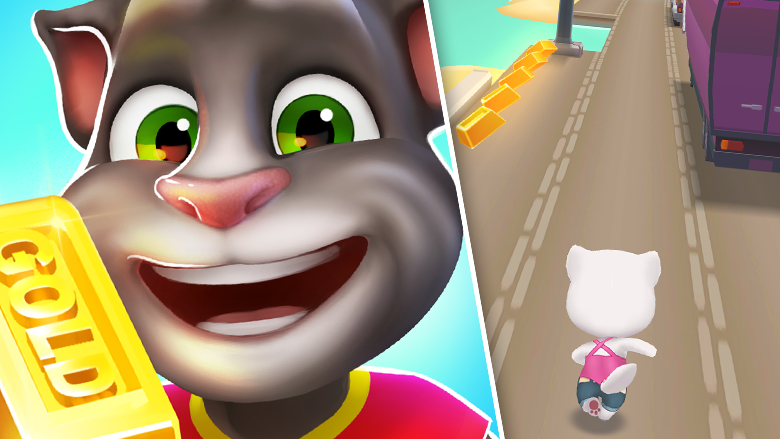
The game is a clone of Subway Surfers with new features and some mechanics combined. Why is it a clone? The developers of Talking Tom Gold Run didn’t only base their game on three-rail track but also copied the visual style, obstacles, and bonuses.
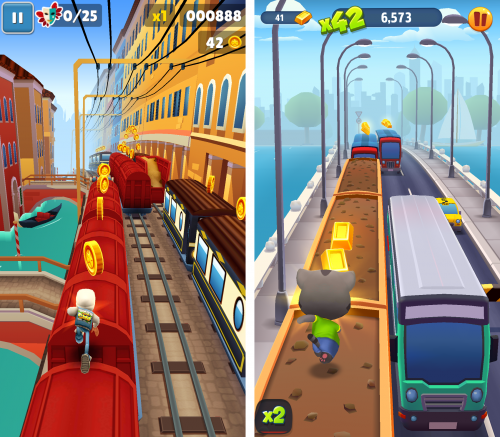
Subway Surfers (on the left) and Talking Tom Gold Run (on the right)
First Impression
The visual part of the Sybo and Kiloo’s game naturally fit in the story of Talking Tom. Graphically Gold Run looks much better. The characters here are cats and dogs which are more appealing and charismatic than the ones from Subway Surfers. The original Talking Tom gained 4.5 billion downloads thanks to its cute characters.
Gold Run shows how important to pay attention to details:
- cars you see are flashing the lights;
- the sound becomes dull when the character puts on the helmet;
- every action in the game has several animations (for example there are four variants of jumps and many “death” types).
Let’s be fair, there are almost no unique character animations in the game. Let me remind you, in the Subway Surfers each character had at least one. In Gold Run, the boys have one set of animations and the girls – the other.
Basic mechanics
There are not so many changes in gameplay and they are mostly unimportant and needless.
A distinctive feature of Subway Surfers was the demonstration of your friends’ records while you run. Gold Run shows only your own records so far, in spite of the fact that there is Facebook sync (even if you have no friends playing the game there should be some high score of other game characters or imaginary people, like in Nonstop Knight).
The number of parts, forming a track, is small (it depends on the number of locations opened, but still).
Subway Surfers memorized additionally made gestures like quick double swipe in different directions. This allowed making short movement combinations at high speed. There is no such thing in Gold Run (Updated on 18.07.2016: it turned out, there are some movement combinations but the animation is slow so it’s not an advantage).
According to subjective feelings, the character responds to swipes a little slower.
There are no daily quests. Originally it was a great reason to return.
No power-up boosters. In Subway Surfers they played an important monetization and achievement roles.
Also, the character runs slowly for a long period of time which seems boring. It’s possible some kind of a monetization funnel so that users who don’t want to waste so much time can make a considerable purchase to skip this part of a track (in Subway Surfers therу is a similar power-up booster).
There is a short-term slowdown in the game after the pause. The main hero moves as if in slow-mo for a couple of seconds if. It allows returning to the interrupted session less painfully.
It is important that Outfit7 left the multiplier in the game.
Subway Surfers was the first to implement the multiplier of points. The score depended not only on the distance but also on the multiplier. The higher the multiplier, the more points a player gets for each step.
The skill wasn’t enough to get a high score, the user had to play a lot and to complete several missions.
In the Sybo Kiloo’s game, you could earn a multiplier for carrying out missions. Each set consisted of three tasks (for example, “do five rollovers”).
The Gold Run also has a multiplier, but you can earn it upgrading buildings.
Minor mechanics
The most interesting thing in Gold Run is the bonding of all gaming mechanics and monetization. Let’s talk about it.
As we have already noted, there is a multiplier in the game. As usual, it is a reflection of a player’s progress. Earlier the progress depended on the finishing packs of missions, now it’s based on the buildings construction.
It creates a basic cycle within the game.

What buildings?
The game has locations. Each location has two or more buildings. Every building can be upgraded five times. Upgrading all buildings to the max opens next location. The location gives access not only to new parts of gaming track but also to a new hero with a unique appearance and characteristics.
To upgrade a building you will need two currencies – gold bars (soft currency obtained on tracks) and diamonds (another soft currency that the player receives from safes).
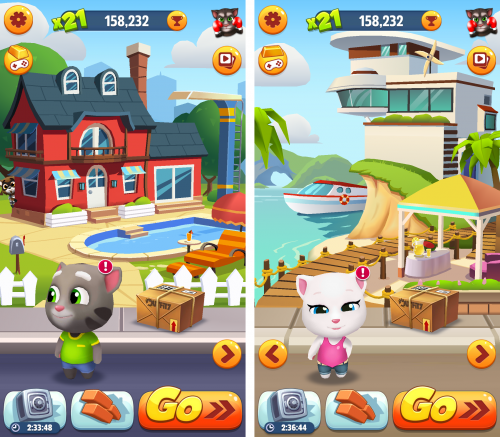
You can see all locations and heroes in the game from the start. But you don’t have an access to them. They are available only when all locations are upgraded to the maximum.

The main motivators in Gold Run are new locations, new characters, and tracks.
As for me, it’s insufficient. You can’t share the progress with your friends, you can’t see what your friend built and so on. This reduces the interest a lot.
Currency
The main soft in-game currency is gold bars. As I have already mentioned, their main source is tracks. You can spend them only on buildings and speeding up in the beginning.
The second soft currency is diamonds. They can be spent only on buildings. The way to get them is more confusing. You can’t buy them. A player gets them only from safes. These safes occasionally can be found on the tracks. How many diamonds will fall out from them, and whether there will be any diamonds, is an open question. In fact, safes are Gacha.
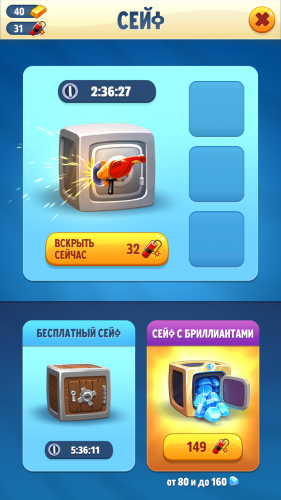
The safes can’t be opened immediately and you can’t keep an unlimited number of them (maximum of four earned on the track, one for hard currency and one for free). This system Outfit7 borrowed from Clash Royale. It takes 3 hours and more to open the safe. I think it’s too long.
The safe could be taken as delayed reward, if we were talking about the cards, which you don’t have, cards to upgrade the deck or simply to merge in a clan.
Instead, we are waiting a small amount of game currency. The delay’s perception is negative in this matter. But it’s a subjective thing. Perhaps, on the contrary, we will see significant growth in sales, because safes can also be blown up for hard currency.
Why are there safes and diamonds?
Gacha and delayed access to it are strongly reducing the rate of consumption of content and at the same time stimulate to make IAPs.
The upgrade of the buildings, which require gold, is quick. On the contrary, the upgrade of the buildings, which require diamonds, is slow. The reasons are obvious. You get a small amount of the diamonds from safes, but upgrades require a lot of them, and safes require time to open. All this is constantly stimulating to buy dynamite.
Dynamite is a hard currency in the game. It’s the only currency, which can be purchased for real money. Dynamite is spent on instantly opening safes, respawns, safes with a guaranteed number of diamonds as well as on buying the required amount of gold for upgrades.
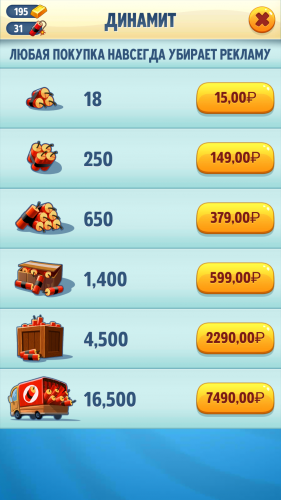
With dynamite’s help, you can quickly see all game content, but a random number of diamonds from safes slows the progress.
It is important to say that earlier such mechanics were not used in casual games. In this aspect, Talking Tom Gold Run is a pioneer.
But then again there is a subjective element. Because of its mechanics, the game makes the user feel pressure.
This problem Outfit7 resolved in their traditional way.
Advertising
Gold, diamonds, dynamite and resources for leveling up your character can be earned after watching an ad video. No limits there. While in many other projects the number of views is restricted, in Gold Run seems like not. At least, I watched eight videos one by one.
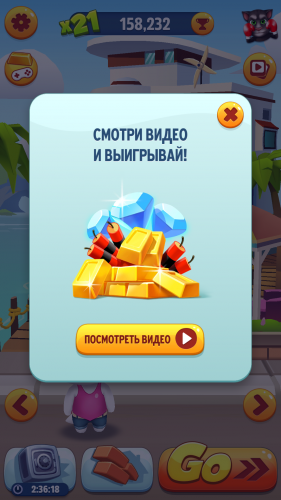
The reward is very small, but it’s come in handy when you miss a couple of diamonds to upgrade a building. Get ready to watch the same videos over and over again.
Availability to watch video ads many times make you feel as if you are not forced to pay.
Also, the game has an offer-wall. It brings a ridiculous amount of gold.
Leveling up
There are power-ups which aren’t included in the basic game circle.
They are placed on all tracks and their activation allows you to get more gold than usual, but it doesn’t last long, just a few seconds.
Power-ups in Gold Run duplicate those from Subway Surfers: magnet, helmet (protects from hits, an analog of skate), plane (analog of jetpack) and “x2”of coins. Power-ups are presented as characteristics of the hero, and can be upgraded.
The heroes in the game are different in their max characteristics. For example, Tom can have 14 magnet points, and Angela only 4. Upgrading is done for tokens that are unique for each characteristic.
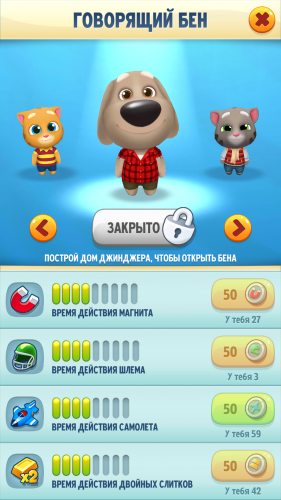
Since the upgrading of each characteristic affects the speed of collecting gold, it is clear that you also have to collect tokens. Just like diamonds, they are always lacking. But they don’t influence the gameplay much.
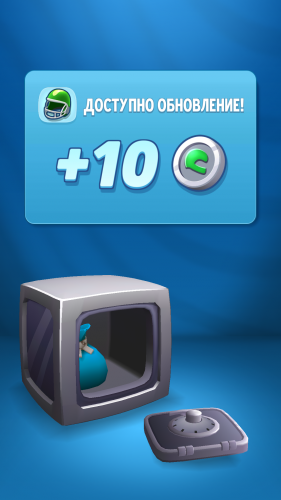
Conclusion
This not the first time when Outfit7 is trying to enter the gaming segment because their other projects about pets are hardly games. Last year’s PvP bubble shooter Mars Pop was a great game, but, as we predicted, didn’t win the audience favor because of the simultaneous multiplayer. Is Gold Run going to be a hit?
It all depends on what the developers expect from the project – downloads or top positions in top grossing. Considering that it’s a brand for kids, the first option is more real.
Runners are very viral and gain installs very quickly. Top hits of the genre – Temple Run and Subway Surfers – has more than a billion of downloads. And the last one is the most downloaded game in Google Play and one of the most downloaded in App Store.
If the company wanted a project that could get more downloads in addition to those from Talking Tom and other games, they hit the target.
I’d follow the project because of the IAP-monetization and safes. It would be an interesting example for a casual game if Outfit7 approach manages to push the game in top grossing.